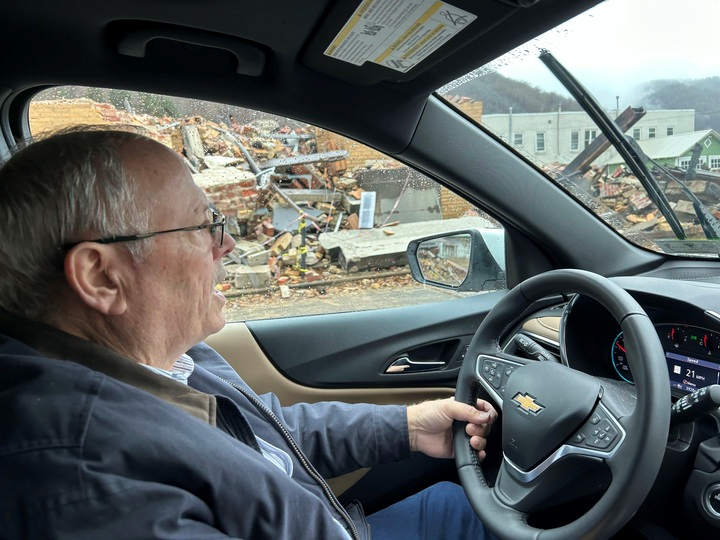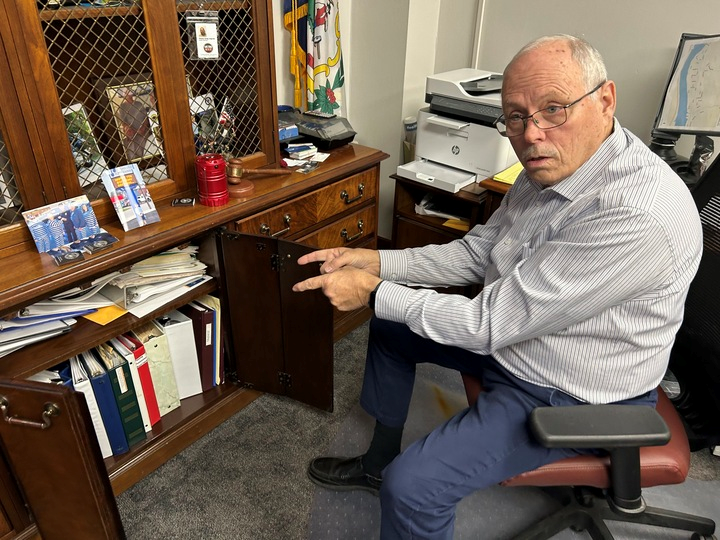Higher education fled this American small town. It left behind 'a ghost town.'
MONTGOMERY, W.Va. – When West Virginia University took the local campus out of Montgomery five years ago, it took more from the rural town than just a college.
Suddenly, 1,500 students were gone. More than 100 staff and faculty moved out. The bar and the car dealership closed. The grocery store, too. And it was only going to get worse, locals knew.
“I see the future of Montgomery going way downhill. Being a ghost town,” Chad Vickers, the former manager of Not Frank’s Pizza, told a Charleston news station at the time. “There’s going to be hundreds of people out of jobs, myself included probably.” He was right. The pizza place used to sit near the campus, and now it’s gone.
All this time later, West Virginia’s decision to move WVU Tech is important not just for what it took away but also for the distrust it fueled with its departure. The residents of Montgomery feel abandoned by the state’s powerful flagship university, which also has become the state’s largest healthcare provider and employer.

The move threatened the town’s livelihood, the city’s mayor, Greg Ingram, said, and reinforced the feeling that rural places like Montgomery were constantly being stripped of their resources – and their dignity. The small town has become even smaller, with just 1,280 residents recorded in the most-recent census. When it left, the university even carted off the city’s beloved World War II cannon, a gift from the nearby city of Charleston that had served as a local landmark for decades.
“In West Virginia, we’re robbing from the poor towns and putting wealth into richer towns,” the mayor said.
If you build it, they will come: West Virginia lures remote workers with $12,000 cash, free access to outdoor activities
Americans are questioning the value of college
Higher education is facing increased skepticism across America. A majority of Americans, across every age group, are now more likely to disagree than agree that a four-year education is worth the cost, according to a Wall Street Journal-NORC poll released in April.
The financial fretting is fairly simple: Prospective students aren’t certain a degree will help their career, but they are fairly certain they will need to go into debt to get it. At the same time, criticism against higher education is increasingly exposing partisan and cultural divides: less the feeling that a four-year degree doesn’t have value, and more that the flagship university doesn’t value them.
Those divides matter even more as American universities have expanded both their academic programs and ways they engage with the larger public, said John Aubrey Douglass, author of “The New Flagship University,” which details how universities have been “expanding their reach into most aspects of modern life.”
First the pandemic, then a ransomware attack force Illinois college to close its doors after 157 years
The positive is that universities can use their talent and research to support local and regional communities, Douglass said. However, poor communication from academics can make faculty seem out of touch or overtly political if they aren’t careful.
“Greater public engagement can also mean greater political entanglement and sometimes expectations from, for example, local governments or businesses, that are difficult to meet,” Douglass said. “There is a need for a more sophisticated approach to university communications and engagement with communities.”
The growing rift is especially felt in rural areas like Montgomery. Many of them rely on local colleges and flagship universities to provide essential services, from firefighting to healthcare, yet are skeptical higher ed leaders have their best interests at heart.
Their frustration is as tangible as the debris of the demolished buildings that now fill Ingram’s daily commute to city hall – as pressing as the rain thumping against his windshield, as his wipers swipe through a past that used to include a thriving downtown.
“This is a Chinese restaurant,” Ingram said, pointing out the window, “but they’re ready to fold too.”

He passes a newer-looking brick building: The Upper Kanawha Valley Economic Development Corporation, which used to lease its basement out to the university for storage space.
“They just went belly up,” Ingram said.
Just as it does nationwide, education serves as a dividing line between Morgantown, where 56% of adults have a bachelor’s degree, and Montgomery, which is mostly in Fayette County, where just 16% have a bachelor’s degree.
They wanted to practice rural medicine. What happened after medical school?
In moving WVU Tech an hour away to the bigger city of Beckley, university officials cited low enrollment numbers that had dropped to under 1,500 students, roughly half its peak. They hoped that the new location would attract more students from neighboring states and throughout southwest West Virginia.
By fall 2022, enrollment had gone up to 1,872 students. That’s still short of the university’s goals. The number needs to be closer to 2,000 to achieve a healthier level, said WVU Tech President Ramon Stuart, who started in January.
For residents here in Montgomery, the decision felt personal. It was the culmination of decades of decline, with populations and voting power steadily falling across this rural stretch of West Virginia.
“There was a chance that this whole area could have been saved,” Montgomery’s fire chief, Benny Filiaggi, said. “We’re trying to create some growth, to live the American dream, but now if you come to this area, you don’t have a place to send your kids to school.”
The year after the university left, the county closed the town’s high school, too, so now many Montgomery kids take a 50-mile round-trip bus ride every day, up narrow hairpin roads to the more populous and prosperous towns up the valley.
“WVU swings a big political club in West Virginia. They get whatever they want,” said Ingram, the mayor. “The administration, it’s cold. That’s a land grant institution. They should not be destroying communities. But they did.”
More: University of Minnesota 'committed genocide' of Native people for financial gain, report says
Outreach or over-reach?
For decades, flagship universities in many states have offered courses at satellite campuses and operated extension offices that help serve the agricultural, health, and youth development needs of rural communities.

That’s also true in West Virginia, which has two satellite campuses and an extension office in all of the state’s 55 counties. The flagship’s president, Gordon Gee, has made it a point to visit each of those counties at least every other summer. This summer, he plans to get to all of them yet again.
Gee said his goal is to make the university essential to West Virginians: in their health, their education, and their economic well-being. In the past decade, he has spearheaded acquisitions that grew the university from three hospitals to 20, now employing more than 20,000 people through its affiliated nonprofit WVU Health System.
“There’s probably no institution that has more of an impact on its state than West Virginia University has on West Virginia,” Gee said.
She helped integrate higher education, and her classmates wanted her dead.
However, what some flagship universities call outreach has sometimes felt like over-reach to the people they’re trying to engage.
It’s a tension felt across the country. In North Carolina, rural residents have said the university system sometimes feels more focused on offering prescriptions than hearing their needs. The attitude is “I’m from Raleigh, and I’m here to help you,” said Misti Silver, a program chair at Mayland Community College in the town of Spruce Pine.
In Wyoming, the dean of the University of Wyoming’s college of education sees how a “tyranny of distance” fosters distrust, with some rural communities located eight hours from the flagship.
To bridge the divide, Scott Thomas has adopted a new model for rural personalization while crafting an asynchronous, mostly online program to start addressing some of the state’s overall teacher retention challenges.
Through that process, the university realized rural educators were less interested in hot-button issues and more curious about how to really create more student-centered environments at their schools.
“We don’t say ‘This is your curriculum.’ We say, “What do you need in your place?” Thomas said. “It’s bringing the University of Wyoming to Wyoming. And that’s different from, ‘Hi, we’re here from the university, and we’re here to help.’”
In West Virginia, Gee – who’s led five universities, including three flagships – is well aware of the growing criticism. He has been criticized for a top-down approach that some have compared to running his universities like corporations. “We can fit the people who can make decisions about the future of West Virginia in a telephone booth,” he often tells reporters, saying that key decisions can be made over late-night texts among him and a few others.
“Every once in a while you’ll hear someone say something, or they’ll say the university is too big or too powerful,” Gee said. “But that’s a better statement than saying the university is irrelevant.”
He remains bullish on the decision to move his campus out of Montgomery, despite the continued enrollment challenges.
The college enrollment crisis: One state offers lessons in how to cope
“We needed to be on the front doorsteps of the southern parts of the state, the coal fields, bringing the engineering school to that part of the state,” Gee said.
To help Montgomery, Gee said the university has offered up its experts to help develop new opportunities – in particular, the West Virginia law clinic helped Morgantown get home rule status and solve some zoning challenges.
“In this instance,” he added, “I can honestly say that everyone has won.”
Even the people of Montgomery?
“You know, I don’t write Montgomery off,” Gee said. “I think those who continue to complain about the move are writing themselves off, and they shouldn’t.”

Making ends meet after a campus closes
In Montgomery, the mayor is still struggling to rebuild. Not just his town’s economy but also its community. “The only thing you gather for is church. You don’t go to a ball game. The college had a theater: People in the community were actors.”
As he drives through the streets, Ingram passes the empty stands at the college’s football field and the old WVU Tech gym and its Olympic size pool, which the city would love to buy, but could never afford to keep up.
The city has already had to raise taxes for the first time in 60 years to make ends meet without the faculty, students, and businesses that used to be its lifeblood.
“When the university left,” Ingram said, “they just left their carcasses here on the community.”
A college closed upending one vet's life Two years later, he’s still rebuilding.
Binders fill the mayor’s office, the result of four economic revitalization studies conducted by the city and its partners over the past few years. Their conclusions are all the same: Move to a tourism-based economy. Take advantage of natural resources. No matter that locals refuse to swim in the river, which is so polluted that some vendors have started selling T-shirts of the three-headed fish rumored to swim in its toxic waters.
Ingram, a former diesel mechanic, made a career of fixing things. Since the university left, he’s had a hard time finding a way.

Still, there was one thing he could make right: After more than a year of negotiations, he finally got the city’s treasured cannon back. And he’s using it to underscore just how bitter the divide has become between his town and the flagship.
“Right now, it’s aimed at Morgantown,” he said. “Gordon Gee’s office.”
Nick Fouriezos covers the role of college in rural America for Open Campus, a nonprofit newsroom focused on higher education. Sign up for his newsletter, Mile Markers.
This article originally appeared on USA TODAY: Higher education fled this American small town. It left a ghost town.


